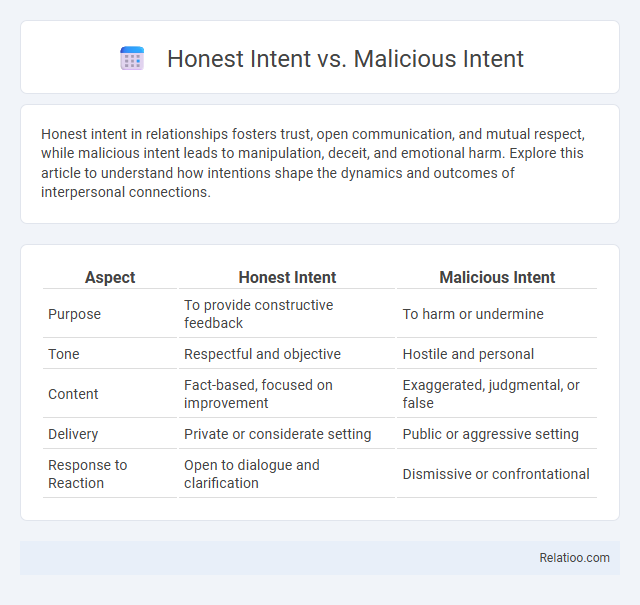Honest intent in relationships fosters trust, open communication, and mutual respect, while malicious intent leads to manipulation, deceit, and emotional harm. Explore this article to understand how intentions shape the dynamics and outcomes of interpersonal connections.
Table of Comparison
| Aspect | Honest Intent | Malicious Intent |
|---|---|---|
| Purpose | To provide constructive feedback | To harm or undermine |
| Tone | Respectful and objective | Hostile and personal |
| Content | Fact-based, focused on improvement | Exaggerated, judgmental, or false |
| Delivery | Private or considerate setting | Public or aggressive setting |
| Response to Reaction | Open to dialogue and clarification | Dismissive or confrontational |
Understanding the Difference: Honest Intent vs Malicious Intent
Honest intent refers to actions driven by genuine, positive motives aiming for beneficial outcomes without deception or harm, whereas malicious intent involves deliberate plans to cause damage, deceive, or manipulate others for personal gain. Understanding the difference between honest and malicious intent is crucial in legal contexts, workplace ethics, and interpersonal relationships to assess accountability and trustworthiness accurately. Intent, in its broadest sense, represents the mental state behind actions, but distinguishing honest from malicious intent requires analyzing motives, evidence, and the consequences of those actions.
Defining Honest Intent: Core Characteristics
Honest intent is characterized by genuine purpose, transparency, and a commitment to ethical standards, reflecting sincerity in actions and decisions. Unlike malicious intent, which aims to cause harm or deception, honest intent involves acting with integrity and prioritizing truthfulness and fairness. Understanding honest intent requires recognizing motives rooted in trustworthiness and respect for others' rights and well-being.
Identifying Malicious Intent: Warning Signs
Identifying malicious intent involves recognizing warning signs such as consistent deceptive behavior, manipulation tactics, and actions that deliberately cause harm or exploit others. Honest intent typically manifests through transparency, clear communication, and genuine efforts to benefit all parties involved. Differentiating intent requires analyzing behavioral patterns, motives, and the impact of actions within various interpersonal or professional contexts.
Psychological Motivations Behind Honest Actions
Honest intent reflects a genuine psychological motivation driven by values such as integrity, trustworthiness, and empathy, often rooted in positive moral development and a desire to maintain social harmony. Malicious intent involves psychological factors like anger, resentment, or a desire for control, rooted in defensive or aggressive mindsets that prioritize self-interest or harm to others. Understanding these distinctions helps you recognize how internal motivations shape behavior, influencing interpersonal dynamics and ethical decision-making.
Common Triggers for Malicious Behavior
Common triggers for malicious behavior include perceived threats, unresolved grievances, and desires for power or financial gain. Honest intent involves actions motivated by transparency and ethical principles, while malicious intent arises from deliberate harm or deception. Understanding these triggers helps differentiate between general intent and actions driven by harmful objectives.
Real-World Examples of Honest Intent
Honest intent involves actions motivated by sincerity and ethical reasons, such as a nonprofit organization providing free education to underprivileged children to improve literacy rates. In contrast, malicious intent includes harmful or deceitful purposes, like hackers targeting financial systems for theft or disruption. Real-world examples highlight that honest intent drives positive societal contributions, exemplified by whistleblowers exposing corporate fraud to protect public interest.
Recognizing Malicious Intent in Everyday Situations
Recognizing malicious intent involves carefully observing behaviors that indicate harm, deception, or manipulation, which differ significantly from honest intent driven by transparency and goodwill. Your ability to discern subtle cues, such as inconsistent statements or aggressive tone, plays a crucial role in identifying potential threats in everyday interactions. Understanding the nuances between honest intent and malicious intent helps protect your personal and professional relationships from exploitation or betrayal.
Impact of Intent on Personal and Professional Relationships
Intent shapes the foundation of your personal and professional relationships by influencing trust, communication, and conflict resolution. Honest intent fosters transparency and mutual respect, leading to stronger connections and collaborative environments, while malicious intent erodes trust, causing misunderstandings and long-term damage. Understanding the nuances of intent helps navigate challenges, ensuring that your actions are perceived positively and relationships remain resilient.
Strategies to Promote Honest Intent in Communities
Promoting honest intent in communities requires fostering transparency, encouraging open dialogue, and implementing clear ethical guidelines that discourage malicious intent and misunderstandings. Your community can benefit from regular workshops on empathy and integrity, as well as platforms that reward truthfulness and accountability. Establishing trust through consistent actions and positive reinforcement helps align individual intent with the community's collective values.
Safeguarding Against Malicious Intent: Practical Steps
Safeguarding against malicious intent involves implementing robust security protocols, continuous monitoring, and user education to detect and prevent harmful activities. Understanding the difference between honest intent, which aims for positive outcomes, and malicious intent, driven by harmful motives, helps tailor defenses effectively. You can protect your systems by regularly updating software, employing multi-factor authentication, and fostering a culture of vigilance to mitigate risks associated with malicious actions.

Infographic: Honest Intent vs Malicious Intent
 relatioo.com
relatioo.com